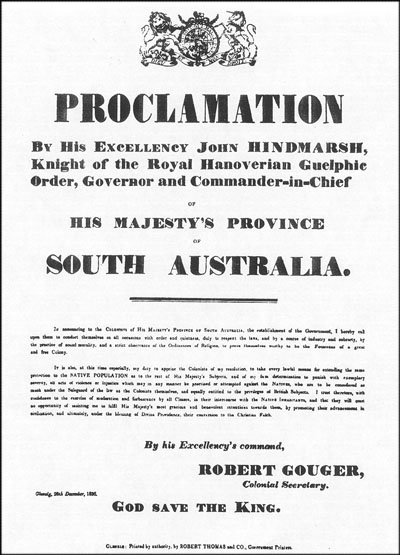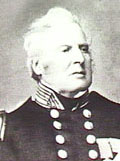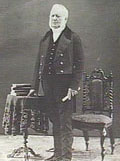The First Government, 1836 - 38

How South Australia was ruled
For the first two years of the colony, South Australia was ruled by the Governor, heading a council of Government - three paid officials appointed by the Crown: The Chief Justice, The Advocate-General, and The Colonial Secretary - and the Resident Commissioner (the representative of the Board of Commissioners in London.
In most other colonies, the Governor had considerable authority. But in South Australia, power was divided between the Governor and the Resident Commissioner, to ensure that the government could not interfere with the business affairs of the colonists, or with their freedom of religion.
The Governor and the Resident Commissioner
The Governor was responsible, to the British Government, for law and order and for providing public buildings, roads and other services. But he had been given very little power to raise money to do all these things. The first Governor was Captain John Hindmarsh, a naval captain with no previous experience of colonial government. His bluff, authoritarian manner made him unpopular with the colonists. Some of the leading colonists were also republicans and disliked having to be respectful to the representative of the Crown.
The Resident Commissioner - James Hurtle Fisher - controlled the sale of land in the colony. Money from this was used to bring out poor labourers as emigrants. Fisher was responsible to the Board of Commissioners in London, was a member of the Executive Council, and controlled much more money than the Governor had access to.
Fisher and Hindmarsh quarrelled on the voyage out to South Australia and could not work together. Fisher refused to set aside any land for government buildings, even forcing Governor Hindmarsh to buy land to put his tent on when he first arrived. As the Governor had few funds, he was unable to provide adequate government buildings in the first two years of settlement. Commissioner Fisher also refused to turn up for Executive Council meetings, making the process of government difficult.
The first Government runs into problems
This system broke down very quickly and in 1838, Governor Hindmarsh and Commissioner Fisher were both recalled to London and replaced. The new Governor was also appointed to the position of Resident Commissioner as well, ending the problem of divided authority. Although this system of government gave very little power to the Governor, it was not democratic or representative either. It was another 15 years before the colonists had any elected voice in the government of South Australia.



